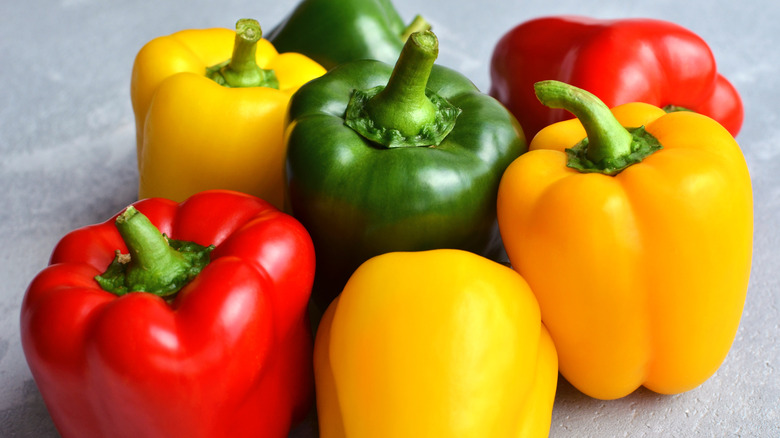Don't Believe This Bell Pepper Myth
Misinformation about food can spread rapidly, particularly in the digital age. Just consider the abundance of canned food myths out there, including that canned vegetables are not as nutritious as fresh produce or that they contain toxins or can't be eaten after their "use by" date.
Even seemingly innocuous and well-intentioned information can quickly make the rounds and lead to misconceptions and false assumptions. A few people share a false post on Facebook or Twitter, and before you know it, a myth has taken root.
One such myth is the mistaken belief that you can discern the gender of a particular bell pepper by counting the number of lobes or bumps at its base. As the widespread fallacy, reported by Reuters, goes, females have four lobes and males have three. This is supposed to matter, allegedly, because female peppers purportedly produce a "sweeter" taste, which is "better for eating raw," while males are more bitter and preferred for use in cooking. And while it's always nice to have additional information to guide you around the kitchen, don't go counting your pepper lobes just yet.
Bell peppers are actually genderless
The bell pepper gender theory sounds great and all, except for one small problem. Bell peppers don't have a gender. Gender and sex don't exist in fruit, as explained in a 2018 article in The Guardian. Furthermore, there is no current research to support the idea that the amount of lobes on a bell pepper has any effect whatsoever on its sweetness.
Oregon State University's Extension Service expounds that "all pepper fruits are ripened ovaries containing seeds formed after pollination." The lobes referenced in the myth are more associated with the growing conditions, genetics, and variety of pepper. Speaking of growing conditions, a pepper that is more ripe will also be more sweet, hence the flavor difference between green and red bell peppers. Thus, the color of the pepper, not the amount of lobes, should guide the flavor profile you're seeking when mulling recipes to make with peppers such as sweet and sour chicken or stuffed peppers.
As the website Gardening Know How elaborates, "it is the flower, not the fruit, which is the sexual organ in plants." Not to mention that while bell peppers do commonly have three or four lobes, they can sometimes have more or less, rendering it a pointless identifier. This is one myth that has been thoroughly debunked.

